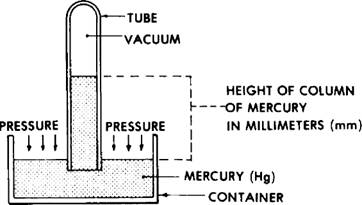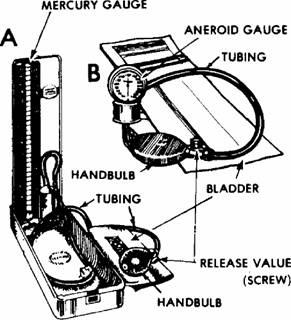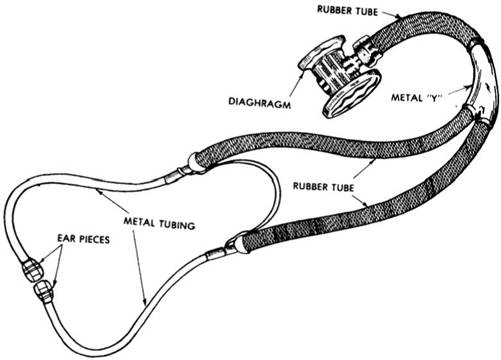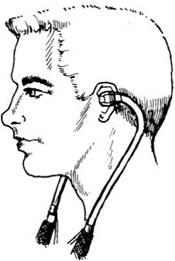
- •Topic 6. Estimation of the patient’s condition and the main parameters of his vital activity. Study of the main parameters of hemodynamics and respiration
- •Tab. Examination of the arterial pulse
- •F igure. Pulse patterns
- •Indirect Blood Pressure Measurement
- •Figure. Effects of an inflated bladder on an artery.
- •Figure. Placement of bladder on upper arm.
F igure. Pulse patterns
Record obtained data. Normal findings. Pulse is symmetrical (pulsus differens is absent), rhythmic, pulse rate is between 60-80 beats per minute, pulse deficit is absent, pulse is of sufficient pressure and volume, of moderate speed and size.
BLOOD PRESSURE
Blood pressure (BP) is a hemodynamic variable dependent on cardiac output and total peripheral resistance.
Blood pressure refers to the force (pressure) with which the blood presses against the walls of the blood vessel. All blood vessels--large or small, artery or vein--have blood pressure. However, the term blood pressure normally refers to the blood pressure of a major artery. Blood pressure is normally measured in millimeters of mercury (mm Hg). "Millimeters of mercury" is a standard unit for measuring pressure. It refers to how high a force (pressure) would cause a column of mercury (chemical symbol Hg) to rise in a tube. Figure gives the general idea. The greater the pressure, the more mercury is forced up the tube.

Figure. "Millimeters of mercury" as a measure of pressure.
EQUIPMENT NEEDED TO MEASURE BLOOD PRESSURE
S phygmomanometer.
phygmomanometer.
The sphygmomanometer (figure) is usually called the "blood pressure cuff." There are several different types of blood pressure cuffs in use. Some are made to be attached to a wall (next to a patient's hospital bed, for example), but most are portable. All blood pressure cuff devices work basically in the same way and have the same parts--a bladder, a handbulb with release valve, a tube connecting the handbulb to the bladder, and a gauge (either mercury or aneroid) for measuring pressure.
Figure . Sphygmomanometers.
A Portable mercury sphygmomanometer. B Portable aneroid sphygmomanometer.
(1) Bladder. The bladder (also called the "cuff") is a long rubber bag that is covered with fabric. The bladder is wrapped around the patient's arm and filled with air when taking the patient's blood pressure. Parts of the fabric are made of non-slip material. When the fabric is overlapped, the two pieces of fabric adhere to each other and will not slip when the bladder is inflated. Some sphygmomanometers use snaps or other devices to secure the bladder instead of non-slip fabric.
Attention to detail is needed for accurate blood pressure measurement. It is important to use the correct size of cuff. A cuff for adults must have a bladder 13-15 cm wide and 30-35 cm long so as to encircle the average arm. Larger cuff are needed for fat arms and smaller cuffs for children.
(2) Handbulb. The handbulb is a device for inflating the bladder. When squeezed, the handbulb forces the air through an opening connected to the tubing. When the bulb is released, it refills with air from the environment. The handbulb is designed so that air from the tubing cannot flow back into the handbulb.
(3) Rubber tubes. One tube connects the bladder and handbulb. Air that is forced out of the handbulb travels through the tube and enters the bladder. A second tube connects the bladder and the gauge
(4) Release valve. The release valve (screw) is a device for releasing air from the bladder. It is located between the handbulb and the tubing. One hand can operate both the handbulb and the release valve easily. The valve is controlled by a screw. When tightened, no air escapes. When unscrewed fully, the air escapes rapidly. (Note: The screw does not separate from the apparatus. "Unscrewed fully" means the screw is turned so that air will escape as fast as possible.) The screw can also be turned to any position between completely closed and full release. In this way, you can let air escape from the bladder as quickly or as slowly as you wish
( 5)
Gauge.
The gauge measures the air pressure in the bladder. There are two
types of gauges--the mercury gauge and the aneroid gauge.
5)
Gauge.
The gauge measures the air pressure in the bladder. There are two
types of gauges--the mercury gauge and the aneroid gauge.
(a) Mercury. The mercury gauge has a column of mercury in a glass tube. The column of mercury measures the air pressure in the bladder. The higher the pressure of air in the bladder, the higher the column of mercury. The height of the column of mercury is determined using a scale to the side of the tube containing the mercury. Usually there is a scale on each side of the glass tube in order to make it easier to read the height of the column. As air is released from the bladder, the air pressure drops and the column of mercury becomes shorter.
( b)
Aneroid. The aneroid gauge is circular and has a dial. The greater
the air pressure in the bladder, the farther the needle on the dial
rotates. A scale on the dial is equivalent to the scale of the
mercury gauge. Both scales measure the force of air pressure in the
bladder in terms of mm Hg. As the air pressure is released, the
needle moves in a counter-clockwise direction. The gauge will
normally be designed so that it can be attached to the bladder. This
frees the person taking the blood pressure from having to hold the
gauge in one of his hands.
b)
Aneroid. The aneroid gauge is circular and has a dial. The greater
the air pressure in the bladder, the farther the needle on the dial
rotates. A scale on the dial is equivalent to the scale of the
mercury gauge. Both scales measure the force of air pressure in the
bladder in terms of mm Hg. As the air pressure is released, the
needle moves in a counter-clockwise direction. The gauge will
normally be designed so that it can be attached to the bladder. This
frees the person taking the blood pressure from having to hold the
gauge in one of his hands.
Stethoscope. The stethoscope is an instrument used for listening to sounds produced within the body. A stethoscope consists of a diaphragm, metal and rubber tubing, and earpieces (figure).
D iaphragm.
The diaphragm is normally a flat metal disk that is placed on the
body area being examined. The diaphragm will pick up sounds produced
within the body such as the heartbeat and breathing sounds. Sometimes
a bell-shaped listening device is used instead of a flat disk. Some
stethoscopes have combination (both flat disk and bell) listening
devices.
iaphragm.
The diaphragm is normally a flat metal disk that is placed on the
body area being examined. The diaphragm will pick up sounds produced
within the body such as the heartbeat and breathing sounds. Sometimes
a bell-shaped listening device is used instead of a flat disk. Some
stethoscopes have combination (both flat disk and bell) listening
devices.
Tubing. The hollow and metal tubes transmit the sounds from the diaphragm to the earpieces. The rubber tubing provides flexibility.
 Figure.
Stethoscope.
Figure.
Stethoscope.
Earpieces. The earpieces are twisted metal tubes with plastic ends. The plastic pieces protect the ears from the metal. The twisting helps to improve the quality of sound heard through the stethoscope. The stethoscope should be worn with the earpieces forward (figure) to help prevent the sounds picked up by the diaphragm from being distorted.
 Figure.
Earpiece of stethoscope in place for use.
Figure.
Earpiece of stethoscope in place for use.
S emi-automatic
and automatic devices for blood pressure measurement at home and for
prolonged (24 h and longer) ambulatory blood pressure monitoring are
now available. It should be stressed that all of these devices should
be tested for accuracy and reliability against standard methods
according to strict protocol. Ambulatory blood pressure monitoring is
an interesting research technique, which is used to investigate blood
pressure variability, behavioral influences on arterial pressure and
the time-course of the effects on antihypertensive therapy. It is
also used, as are home blood pressure readings, to provide a
supplementary source of information for diagnostic and therapeutic
decisions.
emi-automatic
and automatic devices for blood pressure measurement at home and for
prolonged (24 h and longer) ambulatory blood pressure monitoring are
now available. It should be stressed that all of these devices should
be tested for accuracy and reliability against standard methods
according to strict protocol. Ambulatory blood pressure monitoring is
an interesting research technique, which is used to investigate blood
pressure variability, behavioral influences on arterial pressure and
the time-course of the effects on antihypertensive therapy. It is
also used, as are home blood pressure readings, to provide a
supplementary source of information for diagnostic and therapeutic
decisions.
Blood pressure is generally measured by the indirect method, using a sphygmomanometer. N. Korotkoff proposed this method in 1905. In 1953 World Health Organization (WHO) introduced the Korotkoff’s method as a classical world standard for measure BP.
